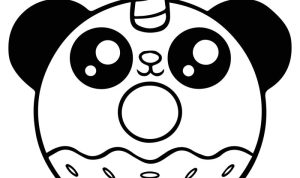Design Elements
Coloring book pictures of flowers – Flower coloring book illustrations require careful consideration of design elements to create engaging and satisfying experiences for the user. The interplay of line weight, detail, style, and color palette significantly impacts the overall aesthetic and difficulty level of the coloring page.
Effective design elements in flower coloring book pictures are crucial for their appeal and usability. The balance between intricate detail and manageable coloring areas is key to a successful design. Similarly, the choice of color palette can evoke specific moods and enhance the overall visual impact.
Line Weight and Detail Level
Line weight, referring to the thickness of the lines, varies considerably in flower coloring book illustrations. Thicker lines are generally used for Artikels and bolder elements, providing a clear structure and making the image easier to color within the boundaries. Thinner lines create finer details, such as delicate petals or intricate leaf veins, adding complexity and visual interest.
The level of detail directly impacts the difficulty and time commitment required for coloring, ranging from simple Artikels suitable for younger children to highly detailed illustrations for experienced colorists. A balance between these aspects is important to cater to a diverse audience.
Color Palettes in Flower Coloring Books
Color palettes significantly influence the mood and aesthetic of a flower coloring page. Pastel shades create a soft, calming effect, while vibrant hues offer a more energetic and lively feel. Monochromatic palettes, using various shades of a single color, can provide a sophisticated and elegant look. Complementary color palettes, using colors opposite each other on the color wheel, can create visual contrast and excitement.
Analogous palettes, using colors adjacent on the color wheel, offer a harmonious and cohesive appearance. The choice of color palette is often dictated by the style and theme of the illustration, as well as the intended target audience.
Artistic Styles for Flower Coloring Book Illustrations
Different artistic styles can significantly impact the visual appeal and complexity of a flower coloring page. Consider these examples:
- Realistic Style: This style aims for a highly accurate representation of the flower’s form, texture, and color. Illustrations often feature detailed petals, realistic shading, and accurate botanical details. This style often appeals to adult colorists who appreciate accuracy and complexity.
- Whimsical Style: This style features stylized and exaggerated elements, often incorporating playful characters, patterns, and fantastical details. Flowers might have human-like features, oversized petals, or unusual color combinations. This style is often more appealing to children and those who enjoy a less structured approach to coloring.
- Geometric Style: This style uses geometric shapes and patterns to represent flowers, creating a modern and abstract aesthetic. Petals might be composed of triangles, squares, or circles, and the overall composition might be highly symmetrical or asymmetrical. This style appeals to those who appreciate minimalist designs and geometric patterns.
Sample Coloring Page: Sunflower, Coloring book pictures of flowers
This sample coloring page features a single sunflower. The design incorporates a realistic style, focusing on accurate representation of the flower’s form and structure. The line weight is varied, using thicker lines for the main Artikel and thinner lines for details such as the individual florets and stem. The level of detail is moderate, allowing for both ease of coloring and the opportunity for creative expression.
The color palette is designed to be warm and inviting, utilizing shades of yellow, orange, and brown, with a touch of green for the leaves and stem. The background is left blank to allow for creative freedom in the coloring process. The overall composition is simple and balanced, creating a visually appealing and satisfying coloring experience. The sunflower’s head is slightly tilted, adding a touch of dynamism to the otherwise symmetrical design.
The leaves are slightly overlapping to add depth and realism, but remain clearly delineated for easy coloring.
Commercial Aspects: Coloring Book Pictures Of Flowers
The market for adult coloring books, including those featuring floral designs, has experienced significant growth in recent years, driven by the therapeutic benefits associated with mindful coloring and the increasing popularity of creative hobbies. Understanding this market is crucial for successfully launching a new flower coloring book. This section will explore the commercial aspects, including pricing, distribution, competitive analysis, and creating a unique selling proposition.
Pricing strategies for flower coloring books vary depending on factors such as page count, paper quality, binding type, and the perceived value of the artwork. Generally, simpler books with fewer pages and standard paper might retail for $8-$15, while more elaborate books with high-quality paper, intricate designs, and perhaps additional features (like perforated pages for easy removal or special binding) could command prices in the $15-$30 range.
Distribution channels include online marketplaces like Amazon and Etsy, independent bookstores, craft stores, and potentially partnerships with larger retailers depending on the book’s success and scale of production.
Market Analysis of Flower Coloring Books
Several popular flower coloring books demonstrate successful strategies. For example, “Secret Garden: An Inky Treasure Hunt and Coloring Book” by Johanna Basford achieved significant success due to its intricate designs and high-quality printing. Its unique selling proposition lay in its detailed illustrations and the “treasure hunt” element integrated into the designs. In contrast, books focusing on simpler, more stylized floral patterns often target a broader audience and are priced more competitively.
Analyzing the features and pricing of these successful titles provides valuable insights into market trends and consumer preferences. A comparison table highlighting key features like art style, page count, paper type, and price point would further illuminate these differences.
Creating a Unique Selling Proposition
A successful flower coloring book needs a clear and compelling unique selling proposition (USP). This could be achieved through several approaches: focusing on a specific flower type (e.g., a coloring book exclusively featuring roses or orchids), employing a unique art style (e.g., watercolor, line art, geometric patterns), incorporating a theme (e.g., a botanical coloring book with educational information about each flower), or offering a premium format (e.g., using archival-quality paper or a lay-flat binding).
A strong USP differentiates the book from competitors and helps attract a targeted audience. For example, a book titled “The Art of Botanical Illustration: A Coloring Journey” immediately conveys a specific focus and target audience.
Steps in Creating and Publishing a Flower Coloring Book
The process of creating and publishing a flower coloring book involves several key steps. First, the creation of the artwork is paramount. This includes sketching, inking, and digital coloring of the floral designs. Following this, the artwork must be prepared for printing, ensuring high resolution and correct color profiles. Next, a publisher or self-publishing platform is selected.
This decision influences aspects like ISBN acquisition, printing, distribution, and marketing. Finally, marketing and sales strategies are implemented to reach the target audience. This could involve social media marketing, online advertising, and collaborations with relevant influencers or bloggers. Successful execution of these steps is crucial for bringing the coloring book to market and achieving sales success.
Coloring book pictures of flowers offer a tranquil escape, allowing for creative expression through vibrant hues and delicate details. For a different kind of creative fun, you might also enjoy the retro charm of a pac man coloring book , but returning to the gentle beauty of floral illustrations provides a calming counterpoint. The intricate petals and varied shapes of flowers present a unique challenge and reward for any coloring enthusiast.






